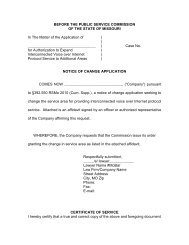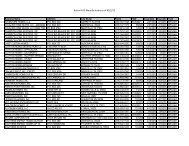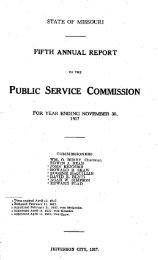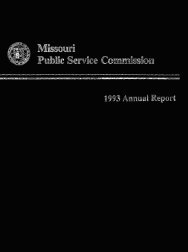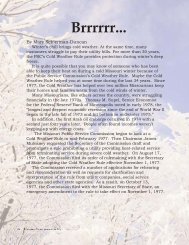2012 PSC Annual Report - Missouri Public Service Commission
2012 PSC Annual Report - Missouri Public Service Commission
2012 PSC Annual Report - Missouri Public Service Commission
You also want an ePaper? Increase the reach of your titles
YUMPU automatically turns print PDFs into web optimized ePapers that Google loves.
REGULATORY ACTIVITYAmerican Recovery andReinvestment Act of 29 ARRAThe <strong>Commission</strong> continued to utilize its $900,000 ARRAgrant to help facilitate analysis and consideration of ARRAelectricity-related topical areas such as: renewable energy,energy efficiency, demand response, energy storage, SmartGrid, plug-in hybrid electric vehicles, coal and carboncapture and storage, transmission and distribution.ARRA funding was utilized for a full-time engineer anda policy analyst to work on such projects. The grant alsoprovides funding for existing <strong>Commission</strong> staff travel andtraining related to the ARRA topical areas. Using ARRA funds,the <strong>Commission</strong> was able to provide on-site training relatedto the modified rate design aspects of the <strong>Missouri</strong> EnergyEfficiency Investment Act and general transmission topics.Federal Activity in ElectricSouthwest Power Pool SPPIn the <strong>2012</strong> fiscal year, the Southwest Power Pool (SPP)conducted studies to determine which transmissionupgrades would likely be needed in 10 years under theIntegrated Transmission Planning (“ITP10”) strategy.The <strong>Missouri</strong> <strong>Public</strong> <strong>Service</strong> <strong>Commission</strong> (<strong>Commission</strong>)was very involved in the “ITP10” planning process: assistingin the identification of transmission system needs in10 years and determining how the costs and benefits ofproposed projects would be estimated, costs allocatedamong the utilities in the SPP region and recovered fromtransmission customers.The final ITP10 report was approved by the SPP Board ofDirectors on January 31, <strong>2012</strong> and contained two projectslocated within <strong>Missouri</strong>. While none of the $1.5 billionprojects identified in the “ITP10” report are currently beingconstructed, the <strong>Commission</strong> expressed concern that theprojects identified were not creating sufficient benefits for<strong>Missouri</strong> ratepayers relative to the costs <strong>Missouri</strong> ratepayerswould owe for the projects.The <strong>Commission</strong> is involved in ongoing discussionswith SPP and SPP stakeholders addressing how to ensure<strong>Missouri</strong> ratepayers will receive benefits commensurate tothe costs of SPP board-approved projects for which they willbe required to pay.Also, <strong>Commission</strong> staff attends and participates in SPPProject Cost Working Group meetings to ensure projects areconstructed using good utility practice and to ensure costoverrunsare constrained. Staff also participates in the CostAllocation Working Group, which advises the <strong>Commission</strong>ers’Regional State Committee on cost allocations methodologies;Economic Studies Working Group, which prepares studyparameters used in forecasts to determine future projectsneeds; and the Regional Tariff Working group, which writestariff amendments to the Open Access Transmission Tariff.Midwest Independent TransmissionSystem Operator Midwest ISOThe Organization of MISO States (OMS) was heavilyinvolved with the Midwest ISO’s planning for its first“Multi Value Projects” (MVP) portfolio, using the new costallocation methodology developed in 2010. OMS and the<strong>Commission</strong> staff advocated diligently through the MISO“Candidate MVP Task Force” regarding what the properportfolio of transmission projects should be, as well asmaking sure that MISO properly stated both the costs andthe benefits related to the planned projects. The MISOBoard approved the 2011 MVP Portfolio in late 2011 as partof its “MISO Transmission Expansion Plan” (MTEP).<strong>Commission</strong>er Robert Kenney served as President of theOMS during the entire <strong>2012</strong> fiscal year. This leadershipinvolved representing OMS at a variety of meetings andadvocating for an expanded OMS role in the MISO costallocation and transmission planning processes at a varietyof venues, including the MISO Advisory Committee meetings.<strong>Commission</strong> staff continued to monitor and participatein Midwest ISO’s Planning Advisory Committee (PAC) andRegional Expansion Criteria Benefits (RECB) Work Groupmeetings. The PAC meetings discuss transmission projectsplanned for the MISO footprint. The RECB meetings are usedto determine the criteria for planning what transmissionprojects are constructed in the Midwest ISO footprint.During the past fiscal year, the <strong>Commission</strong> continued toprovide input on issues involving what scenario analysisshould be performed to determine what transmissionprojects should be built in the future.In addition, OMS continued to participate in the MidwestISO’s efforts to change the calculation of prices at nodeson the transmission grid, a concept known as “Convex HullPricing”. A change in the pricing mechanism utilized bythe Midwest ISO would affect the amount <strong>Missouri</strong> utilitiespay for energy bought from the Midwest ISO as well as theprice <strong>Missouri</strong> utilities would receive when they sell energythrough the Midwest ISO.Federal Energy Regulatory<strong>Commission</strong> (FERC) DocketsFERC Order FERC Docet No. RM-23-FERC Order 1000 is a federal rule reforming federal electrictransmission planning and cost allocation requirements forplanning regions including American Electric Cooperative,Inc. (AECI), SPP and MISO. FERC Order 1000: (1) requiresneighboring planning regions to jointly determine, planand ultimately construct transmission projects that wouldjointly benefit both planning regions in a manner thatwould be more cost effective than if each planning regionindividually designed such projects; (2) requires planningregions to take federal, state and local public policies intoconsideration when planning transmission projects; and(3) removes the Federal Right of First Refusal (RoFR) fromincumbent transmission owners when certain transmissionprojects are being planned and assigned.<strong>Missouri</strong> is in an unusual position in that an RTO boundary(or seam) splits the state between SPP, MISO and AECI. Toensure <strong>Missouri</strong> and its electric ratepayers interests arerepresented, <strong>Commission</strong> staff participates in SPP and MISOFERC Order 1000 working groups. In SPP, staff participatesin the following FERC Order 1000 committees: SeamsSteering Committee, Strategic Planning Committee TaskForce on FERC Order 1000, Seams FERC Order 1000 TaskForce; Order 1000 Draft Tariff Task Force; Regional TariffWorking Group. In MISO, the <strong>Commission</strong> staff participatesin the following Order 1000 committees: Order 1000 “Rightof First Refusal” Task Team; Planning Advisory Committee;and Regional Expansion Cost Benefit Working Group. <strong>PSC</strong> <strong>Annual</strong> <strong>Report</strong>



